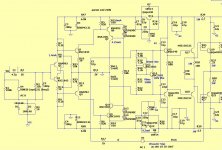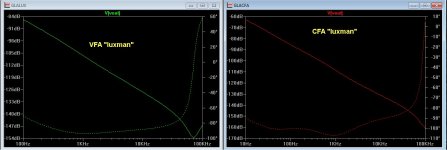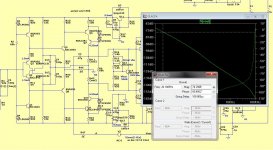Thanks
What's simm THD20k at 100W/4 Ohm for sch from post #2953?
It's 60 ppm, double of that on 8 0hm.
Du..uh! Jas wen i thot i unnesten dis TLAs yus guys start using 4LAs 😱
How about a translation for us unwashed masses?
To add to Dave Zan's comments:
MCP = Edmond's Middle Class Power Amplifier
MCP
DTMC = Double Transistional Miller Compensation
http://home.tiscali.nl/data.odyssey/PMP.html
PS I am definitely part of the unwashed masses too.
Last edited:
I have not read the entire thread so may be repeating something but just picking up one of the posts from around the 20th of Dec about resistance being place at the output of SS amps. JLH was an advocate and would frequently place 0R27 Ohm at the output and he maintained that this reduced the amount of unwanted signal fed back into the amp'.
Btw I am pretty sure Pioneer were one of the first people to take up a license for Edward Cherry's NDFL circuits but I am not sure if they ever used them commercially.
Cheers
Jonathan
Btw I am pretty sure Pioneer were one of the first people to take up a license for Edward Cherry's NDFL circuits but I am not sure if they ever used them commercially.
Cheers
Jonathan
Pioneer A-5 And A-6...
Dan.
Audio Power Amplifier Design Handbook - Douglas Self - Google BooksBtw I am pretty sure Pioneer were one of the first people to take up a license for Edward Cherry's NDFL circuits but I am not sure if they ever used them commercially.
Cheers
Jonathan
Dan.
Monso, What I agreed with Edmond on was the fact that the extra buffer was not needed.
Then what i said about the diamond buffer was, that to my subjective experience it's not sonic invisible. I also explained how I have tested that and stated that it was only my very unscientific observation and that the choice I make is for me, as I do trust my ears well enough to guide me in the right direction. If you feel different it's 100% ok with me.
If you just have you nose into the books, simulators and measurement gear, you really don't know the direction you're heading. I listen to a lot of things, different mirrors, cascodes, output stages, input fets/bjt's CFP inputs and the list goes on and on... All that IRL testing gives me pointers, pointers that can take me in the direction and closer to "what" I want. All is very subjective and unscientific. But when you gather enough information a pattern begins to emerge. With this you can find some viable technical reasons and paths that may lead to better designs and better performance.
Key is to have Direction, without you're lost.
Then what i said about the diamond buffer was, that to my subjective experience it's not sonic invisible. I also explained how I have tested that and stated that it was only my very unscientific observation and that the choice I make is for me, as I do trust my ears well enough to guide me in the right direction. If you feel different it's 100% ok with me.
If you just have you nose into the books, simulators and measurement gear, you really don't know the direction you're heading. I listen to a lot of things, different mirrors, cascodes, output stages, input fets/bjt's CFP inputs and the list goes on and on... All that IRL testing gives me pointers, pointers that can take me in the direction and closer to "what" I want. All is very subjective and unscientific. But when you gather enough information a pattern begins to emerge. With this you can find some viable technical reasons and paths that may lead to better designs and better performance.
Key is to have Direction, without you're lost.
Last edited:
Is there an other way to design best audio gears ?I listen to a lot of things,... and the list goes on and on... All that IRL testing gives me pointers, pointers that can take me in the direction and closer to "what" I want. All is very subjective and unscientific. But when you gather enough information a pattern begins to emerge. With this you can find some viable technical reasons and paths that may lead to better designs and better performance.
I hoped in this forum we could share and compare our listening experiences and our 'subjective' conclusions. But each time you try to say a word about something you have experienced, Like L.C. complain about Diamond buffers, begins a riot from 'objectivists'.
Of course, sometimes, we can be fooled in our conclusions, because what we had experienced was due to a specific situation, not to be generalized.
It is a very difficult way, witch require a lot of efforts, questioning, doubts, in the same time that structured way to analyse and try to understand causes and solutions.
It is so easy to lie only on numbers... it can produce decent things...it is a requisite... it is half the way.
But each time you try to say a word about something you have experienced, Like L.C. complain about Diamond buffers, begins a riot from 'objectivists'.
Ok. I have now created 3 versions using the CFP variant of the diamond buffer input. If there is a signature sound I like it. Vocals appear to the strong point. Although, I believe that other factors in the design, for example, OPS design have a bigger affect.
Personally, having been annoyed at audiophile magazines in the past and their pseudo science approach (if even that), I now like to try and tie the subjective view to the objective view.
Part of the appeal of audio design is this "mystical" element that is difficult to explain through numbers. Why do some designs sound good and others don't. But IMHO there is no excuse not to at least use a well engineered idea.
As i said, it is a requisite.But IMHO there is no excuse not to at least use a well engineered idea.
About Diamond buffers in the input stage, it objectively present enough advantages to figure out how to remove evils, if any.
Advantages ?
- It compensate the base emitter diode offset, thus, allows a no cap approach on feedback loop in a classical CFA.
- It gives better isolation to the input parasitic capacitances in various set-ups.
- It can reduce distortion numbers.
- You can set a low pass filter between the two stages witch will be independent from source's impedance.
To be experienced:
- Matching impedances/currents between buffer and first stage in the loop.
- Isolation between the two stages (serial resistance, low pass filter).
- Fet/Bjt combinations.
I see no reason why we cannot achieve a 'transparent' emitter/source follower.
Last edited:
I have to agree that the diamond buffer on the front end of a CFA seems to me to bring some very good benefits that are not available with competing designs using diode biasing or dual feedback designs.
The DC performance is truly excellent - you can build fully DC coupled amplifiers and the offsets are 1-2 mV.
The DC performance is truly excellent - you can build fully DC coupled amplifiers and the offsets are 1-2 mV.
The DC performance is truly excellent - you can build fully DC coupled amplifiers and the offsets are 1-2 mV.
Agree with this. Even without matching the DC offsets have been good.
As i said, it is a requisite.
About Diamond buffers in the input stage, it objectively present enough advantages to figure out how to remove evils, if any.
Advantages ?
- It compensate the base emitter diode offset, thus, allows a no cap approach on feedback loop in a classical CFA.
- It gives better isolation to the input parasitic capacitances in various set-ups.
- It can reduce distortion numbers.
- You can set a low pass filter between the two stages witch will be independent from source's impedance.
To be experienced:
- Matching impedances/currents between buffer and first stage in the loop.
- Isolation between the two stages (serial resistance, low pass filter).
- Fet/Bjt combinations.
I see no reason why we cannot achieve a 'transparent' emitter/source follower.
I will be the first to say, that i am sceptical. I have build the Lazy Cat version.
Regarding stability, then the Diamond buffer is superior. The one-stage solution does not even come close
I have several that have listened to the amps. And they all point out that the versions with diamond buffer is better regarding transparency.
I will say that there is to much focus on the frontend only. All stages need your full attention.
Sonnya, i don't understand. You says you're sceptical, then seems to just agree with the post you quoted.I will be the first to say, that i am sceptical.
Did-you mean you're sceptical about Diamond buffer evils ?
Well, if an amp is at his stability limit, with some high input capacitance, it can show some overshoot if you decrease input capacitance with an emitter follower just before the input stage. Making-it 'nervous', as L.C. reported, if you don't modify comps. I believe its reports, i don't know the reasons.
Sonnya, i don't understand. You says you're sceptical, then seems to just agree with the post you quoted.
Did-you mean you're sceptical about Diamond buffer evils ?
Well, if an amp is at his stability limit, with some high input capacitance, it can show some overshoot if you decrease input capacitance with an emitter follower just before the input stage. Making-it 'nervous', as L.C. reported, if you don't modify comps. I believe its reports, i don't know the reasons.
Sorry not for being clear.
What i am talking about is DC stability.
The diamond buffer is nervous if you do not add a small damping resistor of up to 10R between the input pair and the output pair of the diamoond buffer.
But then it shows no sign of peaking or overshoot.
So, we agree on this too.
About the VSSA, in order to deal with the base-emitter diode, i would had preferred an input cap than the big lytic at the emitter.
Then, try to change this cap by a BJT for DC coupling.
My proposal was this one:
http://www.diyaudio.com/forums/atta...cfa-topology-audio-amplifiers-nocap-vssa2.gif
To be improved, moving the input filter from input to the bases of the second transistors. It will add the resistance you promoted.
About the VSSA, in order to deal with the base-emitter diode, i would had preferred an input cap than the big lytic at the emitter.
Then, try to change this cap by a BJT for DC coupling.
My proposal was this one:
http://www.diyaudio.com/forums/atta...cfa-topology-audio-amplifiers-nocap-vssa2.gif
To be improved, moving the input filter from input to the bases of the second transistors. It will add the resistance you promoted.
I have to agree that the diamond buffer on the front end of a CFA seems to me to bring some very good benefits that are not available with competing designs using diode biasing or dual feedback designs.
The DC performance is truly excellent - you can build fully DC coupled amplifiers and the offsets are 1-2 mV.
 I must agree , after simulating "the cats" CFA to death , I went
I must agree , after simulating "the cats" CFA to death , I wentback to the drawing board.
The NX by itself has better linearity/lower thd , no filthy caps. But ... real bad
PSRR - fixed that.
Then I tried to figure out if it really was a CFA.
....That's why I bypassed it on the first round.
It behaves exactly like the VSSA , I can run it with NO compensation (small
oscillation) - can not do this with ANY of my 100's of VFA simulations.
I ended up combining the diamond/CFA (I AM convinced - it is !) with a
Hawksford cascode (my already tested luxman) and the HK triple.
This thing "SCREAMS" .... low PSRR , high slew , cool running front end ,
100k perfect square waves. The perfect combo , I glad I took my time and did
not get sidetracked by the controversy.
I also have the same VFA equivalent sim (the real luxman) for comparison .
OS
Attachments
Last edited:
What PSRR did you get on your sim? 50-60 dB is common for a CFA without a cap multiplier. VFA are definitely better in this regard, and there's no getting around it without some mitigation.
But, AFEC is easier, less effort and will get you to 90 dB and over i.e better than VFA PSRR.
But, AFEC is easier, less effort and will get you to 90 dB and over i.e better than VFA PSRR.
-45db LF (20-200hz) "raw" , -70db with multipliers ... and I might add
current mirrors + tie the diamond direct to the rails (next post).
OS
current mirrors + tie the diamond direct to the rails (next post).
OS
I must agree , after simulating "the cats" CFA to death , I went
back to the drawing board.
The NX by itself has better linearity/lower thd , no filthy caps. But ... real bad
PSRR - fixed that.
Then I tried to figure out if it really was a CFA.
....That's why I bypassed it on the first round.
It behaves exactly like the VSSA , I can run it with NO compensation (small
oscillation) - can not do this with ANY of my 100's of VFA simulations.
I ended up combining the diamond/CFA (I AM convinced - it is !) with a
Hawksford cascode (my already tested luxman) and the HK triple.
This thing "SCREAMS" .... low PSRR , high slew , cool running front end ,
100k perfect square waves. The perfect combo , I glad I took my time and did
not get sidetracked by the controversy.
I also have the same VFA equivalent sim (the real luxman) for comparison .
OS
Nice work, ostripper.
For what it's worth, it does not appear that it is any simpler than a corresponding VFA, so the CFA-is-simpler argument seems to go out the window 🙂.
Cheers,
Bob
Nice work, ostripper.
For what it's worth, it does not appear that it is any simpler than a corresponding VFA, so the CFA-is-simpler argument seems to go out the window 🙂.
Cheers,
Bob
What I have found in my simulations, CFA is simpler to compensate. I use OIC with CFA and getting very good PM and GM, but that was very hard to get working with VFA.
BR Damir
All the "frills"
(first attachment for reference) - my "LUX" (VFA) versus an "NX" (CFA)
JUST multipliers ...
OK , last "whack" at this.
Cap multipliers on the VAS/front end , diamond with regulation +
CCS's. (2nd attachment - +schema)
This iteration of the amp lowered THD to .0006% THD20 , nearly "badger/TMC" level. I also gained 6 more db at 20HZ PSRR.
So , your right , Bob .... even with far fewer components vs. performance ,
one needs far more support (multipliers/regulators) for the front end
to even approach VFA PSRR.
When I build this - DUAL MONO is the only way.
I am pleased .... by far the best performance without "compensation tricks" 😀.
PS - to all those simulation "doubters" - I have built and am listening to
most of the "modules" (CCS's /multipliers/OPS/VAS's) in the simulation...
they really work !!
OS
(first attachment for reference) - my "LUX" (VFA) versus an "NX" (CFA)
JUST multipliers ...
OK , last "whack" at this.
Cap multipliers on the VAS/front end , diamond with regulation +
CCS's. (2nd attachment - +schema)
This iteration of the amp lowered THD to .0006% THD20 , nearly "badger/TMC" level. I also gained 6 more db at 20HZ PSRR.
So , your right , Bob .... even with far fewer components vs. performance ,
one needs far more support (multipliers/regulators) for the front end
to even approach VFA PSRR.
When I build this - DUAL MONO is the only way.
I am pleased .... by far the best performance without "compensation tricks" 😀.
PS - to all those simulation "doubters" - I have built and am listening to
most of the "modules" (CCS's /multipliers/OPS/VAS's) in the simulation...
they really work !!
OS
Attachments
- Home
- Amplifiers
- Solid State
- CFA Topology Audio Amplifiers



